Platelet Rich Plasma (PRP)

PRP treatment contains healing growth factors from your own blood that increase your body’s natural ability to repair itself
(Lee ZH, et al Platelet rich plasma for photodamaged skin: A pilot study. J Cosmet Dermatol 2018 May 31). These factors are platelet derived growth factor (PDGF)/vascular endothelial growth factor (VEGF) helping in vascular permeability.
How is PRP procedure been done? PRP is performed in our clinic: blood is drawn from a vein in the arm; a separation procedure extracts and concentrates platelet rich plasma which is injected into the affected region, usually hair or face.
What is the Enriched/double spin PRP? To increase the efficiency of the PRP we use Enriched/double spin PRP to fortify it with growth factors, derived from your own blood. The most important benefit of the Enriched/double spin PRP is that it contains over 10 times higher concentration of growth factors and cytokines, which makes it more effective and efficient from the PRP alone with long-lasting effect (Kurita M et al. Differential effects of three preparations of human serum on expansion of various types of human cells. PRS2008 Aug;122(2):438-448).
.
How does it work? The healing of injured or inflamed tissue involves a complex and precisely regulated series of natural processes within the body. Thrombocytes (platelets) play an important role in this process. At the site of aging tissue, there is a release of growth factors that initiate the restoration of affected tissue. PRP therapy is based on our understanding of these complex processes. With its high concentration of growth factors, PRP injections support the body’s self-healing processes.
Are there any risks? As the patient’s own blood is used to prepare PRP, the risk of disease transmissions, allergic reactions, toxicity or rejection is avoided. Side effects may include mild irritation, bruising, itching, and discoloration which are temporary.
What is the pain level (1-10)? 1 (Easily tolerated).

